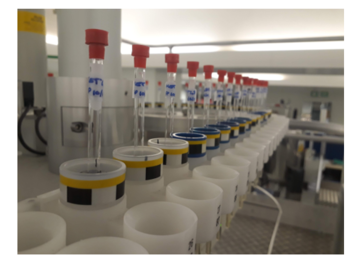Fay Probert

Dr Fay Probert
Dorothy Hodgkin Career Development Fellow

Combining Analytical Chemistry with Multivariate Statistical Methods at the Interface of Medicine and Biology
My research focuses on using a multidisciplinary combination of analytical chemistry, mathematics, and biology techniques to understand the chemistry of small molecule pathways associated with disease. I am particularly interested in better understanding the chemistry of small molecule pathways associated with inflammation in the brain and the effect of therapy on such pathways, with the overall aim of identifying novel drug targets, developing therapeutics, and improving diagnostics for neurodegenerative diseases.
Inflammatory Neurodegenerative Diseases
Neurodegenerative diseases, including Alzheimer’s disease and Multiple Sclerosis (MS), are the leading cause of disability and second leading cause of death world-wide. Although chronic inflammation is a hallmark of such diseases, the mechanisms by which inflammation contributes to cell death are not understood. However, we have previously shown that inflammation in the brain generates profound small molecule changes in blood which are consistent with significantly compromised energy metabolism [PMID: 29208041, 31659123, 31693024, 32709911]. Our current work aims to better understand the relationship between these small molecule patterns (the metabolome) in the blood and the chemical changes associated with different cell types of the brain. We are establishing the viability of using nuclear magnetic resonance spectroscopy (NMR) analysis of blood as a cost effective, non-invasive, and rapid method of diagnosing and monitoring MS progression.
Metabolomics

The field of metabolomics uses analytical chemistry methods (predominantly NMR and mass spectrometry) and advanced statistical analysis to characterise small molecules (metabolites) in biological samples (human, rodent, cell culture) with the aim of better understanding the chemistry associated with disease in complex biological systems, identifying novel biomarkers, and discovering novel drug targets. Metabolomics is a rapidly growing field with a wide range of applications in disease diagnostics, personalised medicine, toxicology, food technology, and systems biology. The direct link between the metabolome and the molecular phenotype means that this powerful approach is ideal for the study of diseases where environment, lifestyle, and genetic factors are believed to play a combined role.
Nuclear Magnetic Resonance Analysis of Biofluids

NMR is a highly reproducible technique that requires minimal sample preparation and allows analysis of blood samples in under 10 minutes. The intrinsically quantitative and non-selective nature of NMR allows every molecule in a blood sample (above a sensitivity threshold) to be measured simultaneously. While the basic molecules that make up blood remain the same across individuals, the relative quantities of the metabolites differ and produce a distinctive pattern that is unique. Thus, a single NMR experiment provides a huge amount of information within a molecular ‘fingerprint’, which is representative of the blood sample. As a result, NMR provides significant advantages over other techniques that can only quantify a single molecule at a time and, by analysing the fingerprint of metabolites in combination, can provide a more powerful means of diagnosis. For example, an increase in the amount of molecule A alone may not be sufficient to diagnose or stage a disease while increases in molecules A and B, combined with a decrease in molecule C could enable accurate diagnosis.

Machine Learning & AI
Owing to the information-rich nature of NMR, advanced statistical techniques (multivariate analysis and machine learning) are utilized to extract the molecular patterns that relate disease stage and prognosis. These statistical tools build complex equations able to distinguish NMR spectra of blood samples from different groups of patients. Once these equations have been calculated and independently tested on a large cohort, they can be used to classify new blood samples. This not only provides a means of diagnosing disease but, by interrogating the metabolites responsible for the discrimination, provides clues into the underlying pathology of the disease.
Fay graduated from Warwick University with a BSc in Mathematics before moving to the Department of Chemistry where she completed an MSc in Mathematical Biology and Biophysical Chemistry. Since completing her PhD in Analytical Chemical Biology, Fay has worked at Bruker (UK) and the Medical Research Council (Harwell) applying analytical chemistry techniques, with a focus on NMR spectroscopy, to a range of biological and medical research questions. Throughout her postdoctoral career, Fay’s research has focused on using a multidisciplinary combination of analytical chemistry, mathematics, and biology techniques to understand the chemistry of small molecule pathways associated with disease. In particular, Fay is interested in better understanding the chemical processes associated with inflammation in the brain with the aim of improving the diagnosis and treatment of these diseases.
Fay joined the Department of Pharmacology at Oxford in October 2015 as a senior postdoctoral researcher in the Anthony lab managing a small team of metabolomics researchers and leading several projects which aim to develop NMR metabolomics and multivariate statistical methods to better diagnose, monitor, and predict treatment response in inflammatory diseases of the central nervous system. In 2018, Fay was awarded a Junior Research Fellowship at Somerville College, Oxford.
In 2021 Fay was a awarded a Dorothy Hodgkin Career Development Fellowship in the Chemistry Department.
Fay has received research funding from the MS Society, MRC, EPSRC, BSRC, Merck, and Numares AG.
NMR Metabolomics Website
Contact
Research groups and collaborators
Prof Tim Claridge; NMR Facility
Prof Daniel Anthony; Experimental Neuropathology
Prof James McCullagh; Mass Spectrometry Facility




